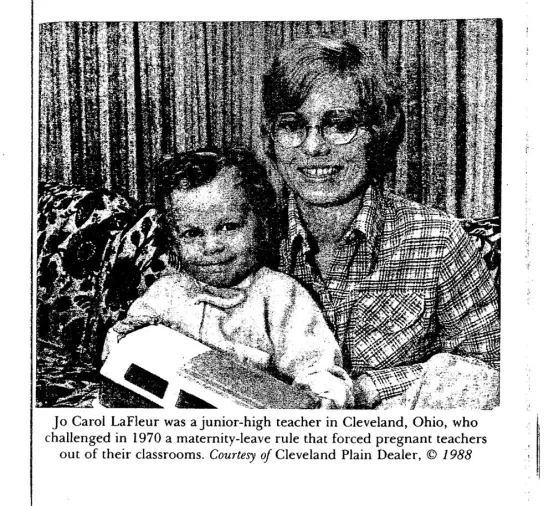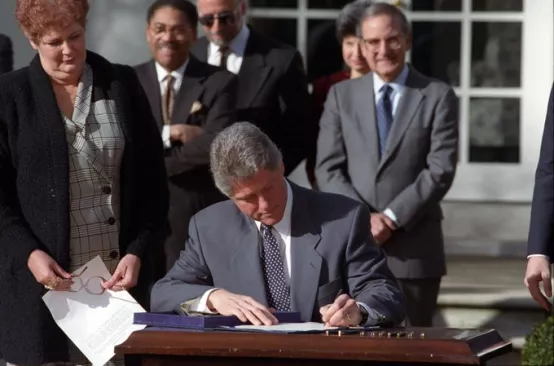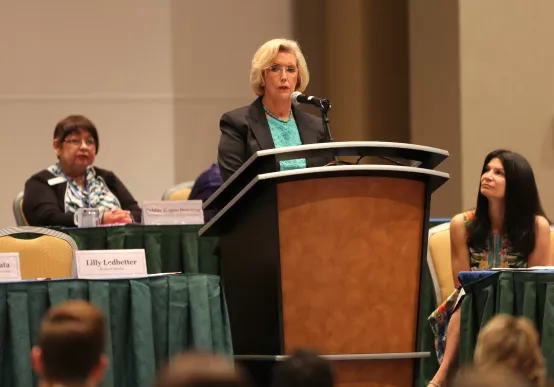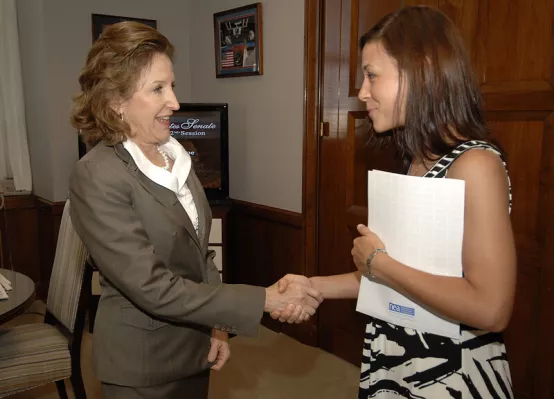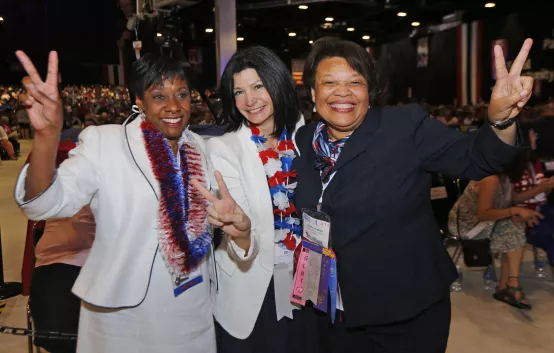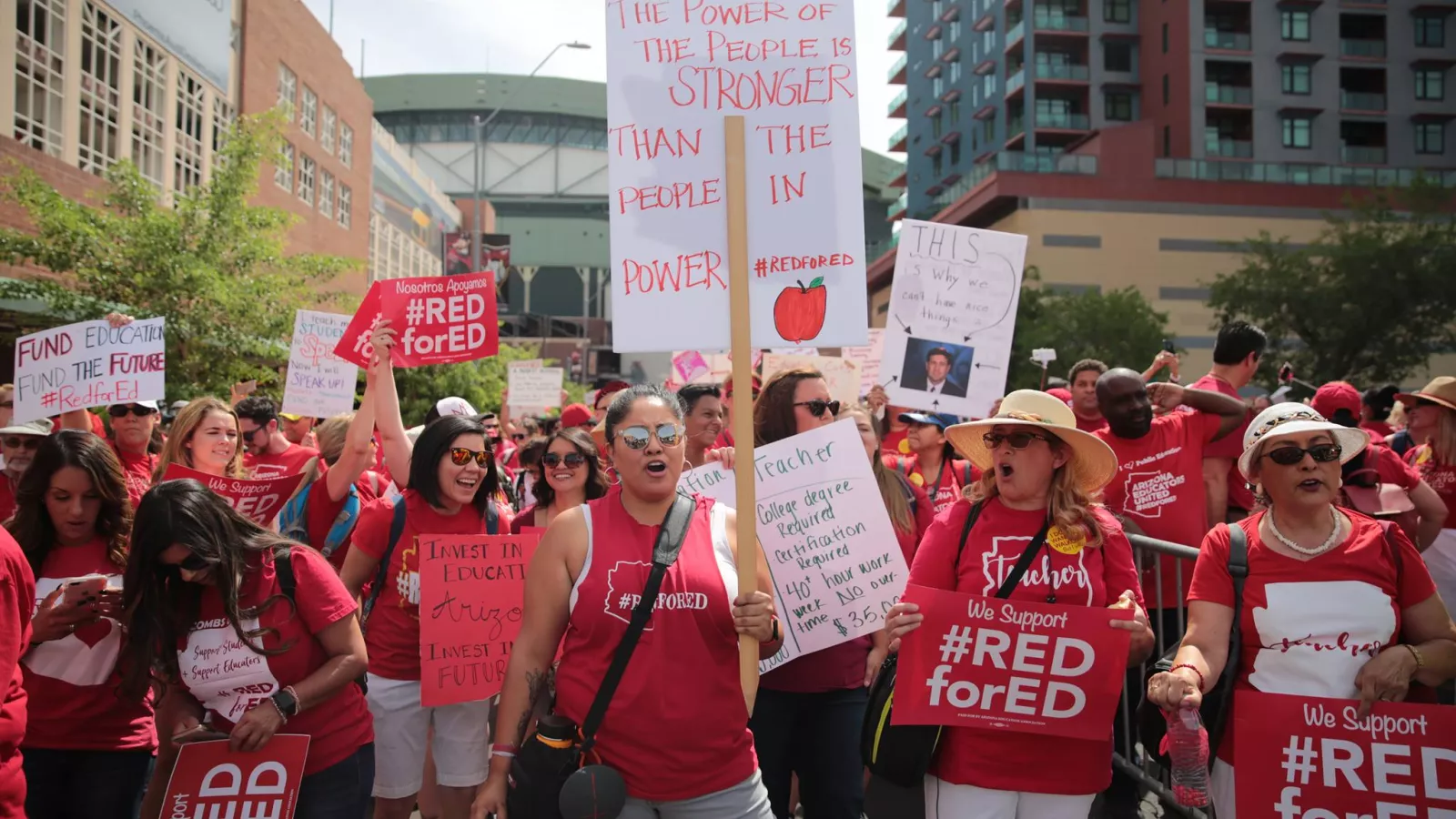1974
NEA Wins Supreme Court Victory
It’s hard to believe now—but 50 years ago, pregnant teachers were commonly forced out of their classrooms as soon as they looked pregnant. This ended with a lawsuit filed by a Cleveland teacher named Jo Carol LeFleur that NEA helped take all the way to the Supreme Court. During testimony, the Cleveland school board’s attorney complained that the city’s pregnant teachers “just would not” leave unless forced by the board to do so, and that a pregnant woman was “not an able-bodied person.” Not only are they distracted, “They urinate more frequently," he said. By a 7-to-2 vote, justices sided with LeFleur. “While it might be easier for school boards to conclusively presume that all pregnant women are unfit to teach past the fourth or fifth month, or even the first month of pregnancy,” Justice Potter Stewart wrote, for the 7-to-2 majority, in January 1974, “administrative convenience alone is insufficient to make valid what otherwise is a violation of due process of law.”
1978
In Defense of Pregnant Workers
On the heels of NEA’s Supreme Court victory, the Pregnancy Discrimination Act (PDA) passes Congress in 1978. The PDA makes it illegal for employers to discriminate against women because they are pregnant, were pregnant, or are of an age where they could become pregnant. It also makes it illegal to discriminate against those who have had or are considering an abortion. In other words, women can’t be fired, or denied a job or job promotion, given a worse schedule, have their pay cut, be harassed by their employers or coworkers, be forced to take leave, or denied accommodations because they are pre-menopausal women. This kind of discrimination was commonplace in the 1970s, noted the late Supreme Court Justice Ruth Bader Ginsburg, in a New York Times article that she wrote decades before ascending to the bench. “Women's child‐bearing function has always played a central role in supporting sex discrimination,” she wrote. “Anticipating the woman's withdrawal from the paid labor force when she becomes pregnant, the economy‐minded employer keeps her till then, at the lowest cost, and at the lowest rung of the job ladder.”
1980
Sexual Harassment in the Bullseye
The same year that Dolly Parton (NEA's 2022 Friend of Education) sang in the movie "9 to 5" about a lack of workplace promotion and a surfeit of workplace harassment, the U.S. Equal Employment Opportunity Commission (EEOC) declares sexual harassment a violation of Title VII and establishes guidelines that define it as “unwelcome sexual advances, requests for sexual favors, and other verbal or physical conduct of a sexual nature.”
1982
More Unions for More Women
On a spring day in New York City’s Chinatown, more than 20,000 garment factory workers—almost all of them women—march down Mott Street, wearing union hats and carrying picket signs. Led by Katie Quan, May Chen and others, the women strike for union contracts, better pay, and improved working conditions. At this time, about 18 percent of working women are members of unions, compared to nearly 30 percent of men, according to U.S. Bureau of Labor Statistics.
1984
Equity for Women in Retirement
NEA wins passage of the Retirement Equity Act, which ends the ability of retirement funds to discriminate against women. Among its many provisions, the new federal law prohibits pension plans from counting parenting leaves as a “break in participation” for participation or vesting purposes. “This important legislation is the first private pension bill in our history to recognize explicitly the importance of women both to the American family and to the nation's labor force,” says then-President Ronald Reagan, as he signs it into law.
1986
Our Union Allies Win for Women, Too!
Also, in 1986, AFSCME wins a $106.5 million settlement in its sex‐based wage discrimination suit against Washington State. As a result, nearly 35,000 women who were working for the state in undervalued job classifications get pay increases.
1993
The Advent of the Family Medical Leave Act
It often falls to women to provide care for family members—and sometimes it’s not possible to provide that dedicated care while working full time. In 1993, President Clinton signs the Family and Medical Leave Act (FMLA), providing time off to employees to care for themselves or their families and ensuring they have jobs to return to.
1993
The Teacher Pay Penalty
For decades, the Economic Policy Institute has been tracking the “teacher pay penalty,” or the difference in pay for teachers compared to comparable college graduates. In 1993, the penalty hits its lowest point between 1980 and 2022—just 5.1 percent, meaning that teachers, on average, are earning 5.1 percent less than similarly educated professionals. By 2021, the gap would grow to 23.5 percent. Experts say teachers are underpaid because the job is so closely identified with women—and “women’s work” isn’t valued.
2005
The Right to Complain about Sex Discrimination
When Roderick Jackson, a basketball coach at a public high school in Birmingham, Alabama, discovered that his team wasn’t receiving equal funding and his players denied equal access to athletic equipment and facilities, he complained to his supervisors. And then…they fired him. Jackson sued, saying he was being retaliated against for complaining about sex discrimination. In 2005, the Supreme Court rules that—even though Jackson himself wasn’t the victim of sex discrimination—federal law gives him the right to sue and protects him from retaliation.
2009
Our Hero: Lilly Ledbetter
Just nine days after taking office, President Obama signs his first piece of legislation—and it is the Lilly Ledbetter Fair Pay Act of 2009. Ledbetter had been working at Goodyear Tire for nearly 20 years when she found out that, while she was getting paid $3,727 a month, men doing the exact same job were getting as much as $5,236. Ledbetter sued, but lost when the Supreme Court ruled she would have had to sue within 180 days of her first paycheck. (She had no idea, at that time, of the pay disparity.) In 2009, the Fair Pay Act loosens that time requirement, enabling more victims of pay discrimination to sue for their fair wages. In 2013, Ledbetter spoke to educators at a NEA conference: “The teachers that I had in high school inspired me to be the best possible individual and to achieve all the way to the sky,” she said.
2010
Women Saving Educators' Jobs
About 300,000 teachers across the nation receive pink slips from school districts that can’t afford to pay them anymore. In response, NEA members flood Capitol Hill in the spring and summer of 2010, asking lawmakers to pass the Education Jobs Fund. Fourth-grade teacher Gina Frutig, who was one of 237 Durham, N.C., teachers to get laid off, is one of them. (Frutig, above, is pictured with then-U.S. Sen. Kay Hagan of N.C.) Thanks to their advocacy, the $10 billion program passes.
2013
Honoring Union Legend, Dolores Huerta
Dolores Huerta was a schoolteacher in the 1950s when she realized she could do more to help the hungry children in her classroom by becoming an advocate and organizer of their parents, California’s farm workers. In 1962, she and Cesar Chávez co-founded the National Farm Workers Association, which became the United Farm Workers’ Union. In the 1970s, Huerta led a national boycott of grapes, which brought about the California Agricultural Labor Relations Act of 1975—legislation that enabled farmworkers to form unions and collectively bargain for safer working conditions and better pay. In 2013, she joins NEA members at a summer conference, where she is honored for her decades of service.
2014
NEA Elects First All-Women, All-People-of-Color Team
Delegates to the NEA Representative Assembly in 2014 elect the first all-women, all-people-of-color team to head the nation’s largest union, with Lily Eskelsen García as then-president, Becky Pringle as then-vice president, and Princess Moss as then-secretary-treasurer.
2018
#RedforEd Sweeps Nation
In states across the nation, teachers begin striking for more school funding and better pay. At the same time, women across the nation are leading a #MeToo movement, raising awareness of sexual harassment and violence. In an interview with The Guardian, then-NEA President Lily Eskelsen García notes both movements are being led by women, raising their voices together and striving to make the world a better place. “If you look at the strongest unions today, they are our public sector education unions and these are unions that by and large are made up of women with women leaders,” said García. “We are not sitting by and accepting the status quo.”
2021
Paid Family Leave Gets Momentum
It’s been nearly 50 years since the Supreme Court made sure that pregnant educators wouldn’t be forced out of classrooms…but educators are still struggling with the care of those children, post-pregnancy or adoption. In 2021, NEA-affiliated union members at the University of Florida negotiate an eight-week paid family leave benefit. “Even though it seems to me that [paid family leave] should be a given, it has been a long fight,” says Hélène Huet, a member of the United Faculty of Florida-UF bargaining team. The following year, educators in Columbus, Ohio, and Malden, Massachusetts, go on strike, in part, to win paid family leave.
2022
Solving the Student Debt Crisis
Student debt is a women’s issue. Federal data shows women owe the majority of student debt, and they take an average two years longer to pay back their debt. Black women, in particular, are the most likely to have student debt. In 2022, NEA members make real progress in fixing the nation’s student debt crisis. After hearing from 168,000 NEA members, the White House announces fixes to the Public Service Loan Forgiveness program and a new cancellation program. Thanks to these improvements, by late November 2022, about 373,000 borrowers have qualified for Public Service Loan Forgiveness.
